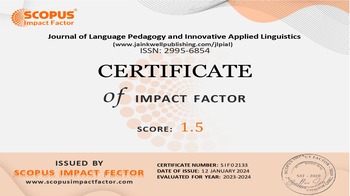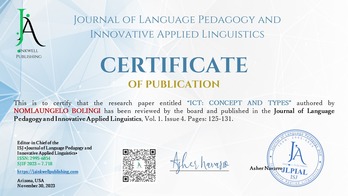Embracing Language Learning: The Direct Method and Its Advantages in Fostering Effective Communication
DOI:
https://doi.org/10.1997/24pn0k95Keywords:
speech, direct method, target language, classroom interactionAbstract
This article provides a comprehensive overview of the Direct Method, highlighting its distinctive features and discussing its benefits. It explores the roles of both teachers and students within the classroom, emphasizing the importance of speech and fostering interaction in the target language. Additionally, the article examines the factors that set the Direct Method apart from other language teaching methods.
Downloads
References
Duchakova S. (2006) Method and Approaches in Foreign Teaching Language Diploma Thesis.
Rivers, W (1981). Teaching Foreign Language Skills. Chicago and London
Zaree. H (2000). Direct Method and the Natural Approach.
Zafarovna, F. Z. (2023). The problem of translation of proper names in fantasy genre texts on the material of J. Rowling's novel" Harry Potter and the Philosopher's Stone" and its translation into Russian. Ustozlar uchun, 19(2), 28-32.
Zafarovna, F. Z., & Rustamovna, B. A. (2023, June). Phonetics of the English Language as a Science, Academic Discipline and Art. In Proceedings of Scientific Conference on Multidisciplinary Studies (Vol. 2, No. 6, pp. 53-56).
Zafarovna, F. Z. (2023). The Functional Styles of Modern English Language.
Zafarovna, F. Z. (2023). The Translation of the Author's Metaphor in a Literary text. Pedagogs jurnali, 29(1), 67-70.
Zafarovna, F. Z. (2023). The Functional Styles of Modern English Language.
Файзуллоева, З. З. (2022). The Peculiarities of Literary Text and Difficulties of its Translation. Международный журнал искусство слова, 5(6).
Fayzulloyeva, Z. Z., & Murzina, E. A. (2022). Difficulties Faced by EFL Teachers in Teaching English to the Students in Rural Schools. Ученый XXI века, (10 (91)), 80-81.
Файзуллоева, З. З. (2022). The Peculiarities of Literary Text and Difficulties of Its Translation. Международный журнал искусство слова, 5(6).
Балясникова, М. А. (2023). К этимографии символа “радуга” в индоевропейских языках. Международный журнал искусство слова, 6(3).
Balyasnikova, M. A. (2021). Recurrent Images in Wordsworth’s Poetry. Theoretical & Applied Science, (4), 104-109.
Marina, B. (2019). Asyndeton in the dramas of Shakespeare. In Bridge to science: research works (pp. 101-103).
Balyasnikova, M. A. (2019). Word-Formation Processes and Semantic Change in Coining Loan Translations. Вестник магистратуры, (5-5), 22.
Балясникова, М. А. (2018). Словосочетания с адпредикативным instrumentalis comparationis. ЕВРАЗИЙСКИЙ НАУЧНЫЙ, 37.
Aleksandrovna, B. M. (2017). Exclamatory Repetitions in Shakespeare's Tragedy" Hamlet". Евразийский научный журнал, (12), 129-131.
Aleksandrovna, B. M. (2017). The recurrent images producing an impression of supernatural presence, suspense and fear in Coleridge’s poem “the Rime of theancient Mariner”. Евразийский научный журнал, (6), 240-242.
Балясникова, М. А. (2016). Семантизация образной диады ‘собака’/’волк’в индоевропейских языках. Ученый XXI века, (2-4).
Расулов, Н. А. (2023). Инглиз тилида реалис/ирреалис ҳодисасини ташкил қилувчи бирликларнинг лексик-семантик структурал хусусиятлари. Международный журнал искусство слова, 6(4).
Расулов, Н. (2018). Интерпретация образа в художественном переводе (на примере перевода на русский и узбекский языки произведения ВЛ Войнич «Овод»). Иностранная филология: язык, литература, образование, 3(2 (67)), 63-65.
Эрданова, З. (2021). Инсоннинг касбий фаолияти билан боғлиқ тил бирикмаларининг шаклланиши. Общество и инновации, 2(9/S), 186-190.
Abulkasimovna, E. Z. (2021). Comparing Uzbek proverbs and English proverbs in literary. Thematics Journal of Social Sciences, 7(1).
Эрданова, З. А. (2021). Замонавий лингвистикада инсон ва унинг фаолияти акс этилиши. Международный журнал искусство слова, 4(5).
Abulkasimovna, E. Z. (2021). The Problem of the Norms of Phraseological Units Erdanova Zebiniso Abulkasimovna. Mental Enlightenment Scientific-Methodological Journal, 74-81.
Siddikova, N. N., Makhmudovna, M. A., & Alisherovna, O. I. (2021). Philosophical and methodological analysis of organizational learning concepts. Academicia: An International Multidisciplinary Research Journal, 11(2), 403-407.
Qizi, O. I. A. (2022). Enhancing the role of authentic materials in teaching process. Academicia: An International Multidisciplinary Research Journal, 12(6), 257-260.
Ochilboyeva, I. A., & Qudratova, D. R. (2021). Teaching Methodology of Conversation and its Usage in a Foreign Language. Academic research in educational sciences, 2(4), 1856-1863.
Ochilboeva, I. A. (2020). The Role of Analytical and Synthetic Languages in Modern Linguistics (On the Example of Several Languages). Theoretical & Applied Science, (4), 588-591.
Alisherovna, O. I., & Ravshanovna, Q. D. Communicative Language Teaching in ESL Classes.
Downloads
Published
Issue
Section
License
Copyright (c) 2023 Xulkar Bahodirova, Zaynab Shermamatova (Author)

This work is licensed under a Creative Commons Attribution 4.0 International License.












